
|
It can occasionally feel as if there's never really a good time to take time off work. Going on vacation is supposed to be one of the most relaxing things we do, but deadlines and meeting invites stand between employees and their ability to put PTO to good use. For many workers, this was even more true in 2020 when taking time off during the COVID-19 pandemic didn't just feel challenging, it may also have felt like a waste with nowhere to go.
For businesses, encouraging healthy time-off practices isn't just about the benefits it can have on teams and their mental health. Studies also show that taking time away from work can make us even more productive when we eventually make it back to our desks, by lowering stress and boosting cognitive function. Either way you choose to look at it, personal time off is good for business.
So how do some businesses make it easier to take time off, and how do those policies change outside the U.S.? To find out, we surveyed nearly 1,000 people across the United States and Europe to find out how people in these regions think about and approach going on vacation. Read on as we explore how many days Americans and Europeans take off each year, on average; how often work prevents them from putting in PTO; how sick time factors into their ability to go on holiday; and how taking time off influences workplace happiness.
The U.S. notoriously has one of the worst time-off policies among first-world countries, even being referred to as the "no-vacation nation". But the number of days employees are awarded for time off doesn't matter nearly as much as the number of days they actually spend on vacation or taking personal time off away from the office. When employees work in a culture where time off isn't prioritized or encouraged, they may be less inclined to take it for fear of judgment or falling out of favor.
Among those surveyed, Americans reported taking 14 days off per year, on average, compared to 24 days for Europeans. But while Europeans reported taking off 10 more days each year, 43% also said they had to put in their time-off requests more than a week in advance, compared to just 23% of Americans having to do so. According to 37% of Americans surveyed, the most common notice period required for taking time off was between one and two days in advance. On average, Americans were comfortable taking a maximum of eight days off consecutively versus 12 days for Europeans.
Despite taking 10 fewer days off, on average, 70% of U.S. employees said they felt they got enough time off from work, compared to just 16% who said they weren't getting enough time away. In contrast, 53% of Europeans were content with the amount of time they were getting off from work, while 28% said it wasn't enough.
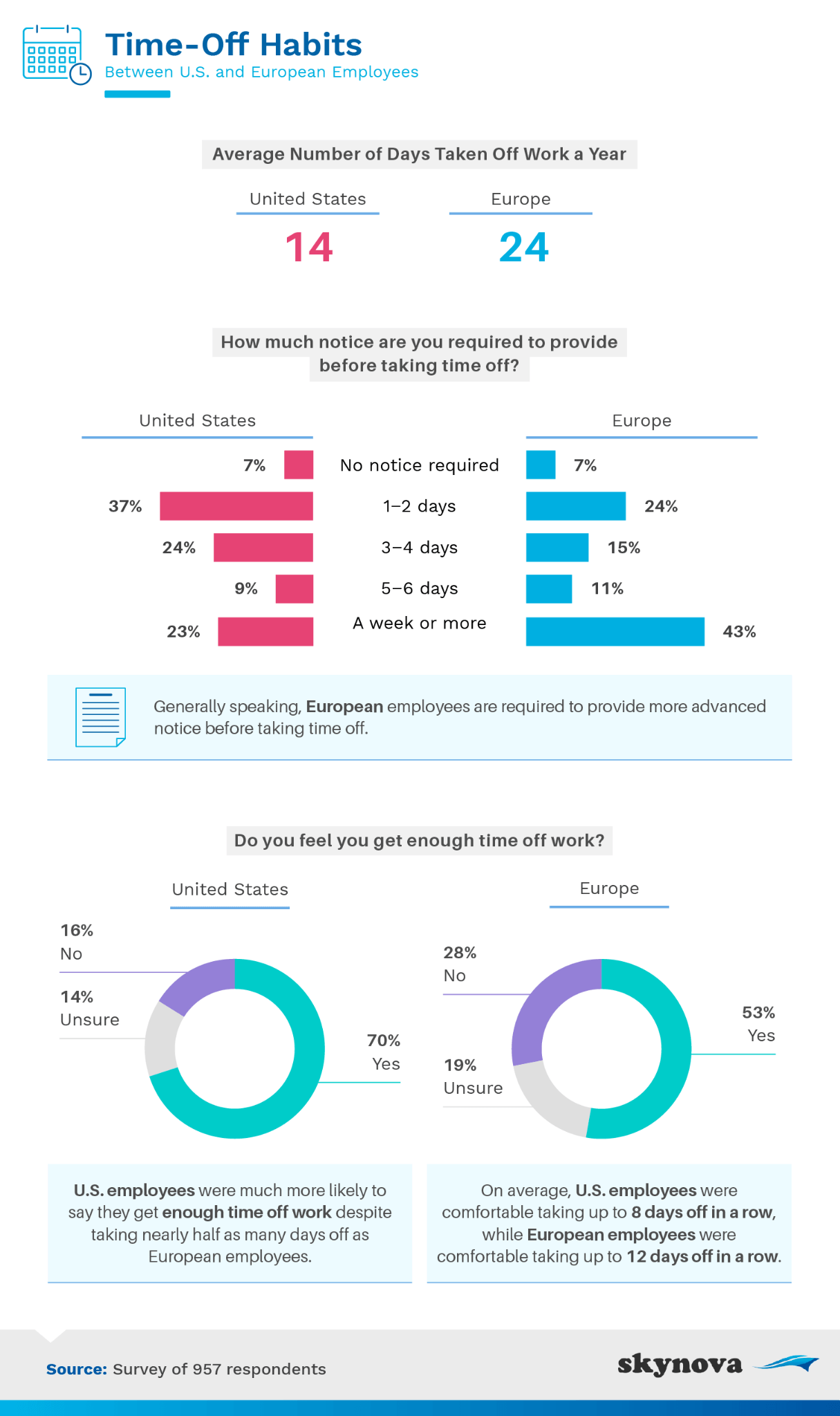
Americans (70%) were the most likely to report getting enough time off during the year, but received less time off, on average (14 days), than those from Spain (22), the United Kingdom (24), Germany (24), and France (28).
For businesses, it can be difficult to cultivate a culture that encourages team members to take a break when their bandwidths are maxed out, and many employees reported that their quantity of assignments kept them from getting the time off they needed. Among Americans, 41% said their workloads often prevent them from taking personal days (41%), vacation days (40%), and sick days (29%). Less than 1 in 10 said their workloads never come between them and personal days off from work, and fewer than 1 in 5 said the same about taking sick days.
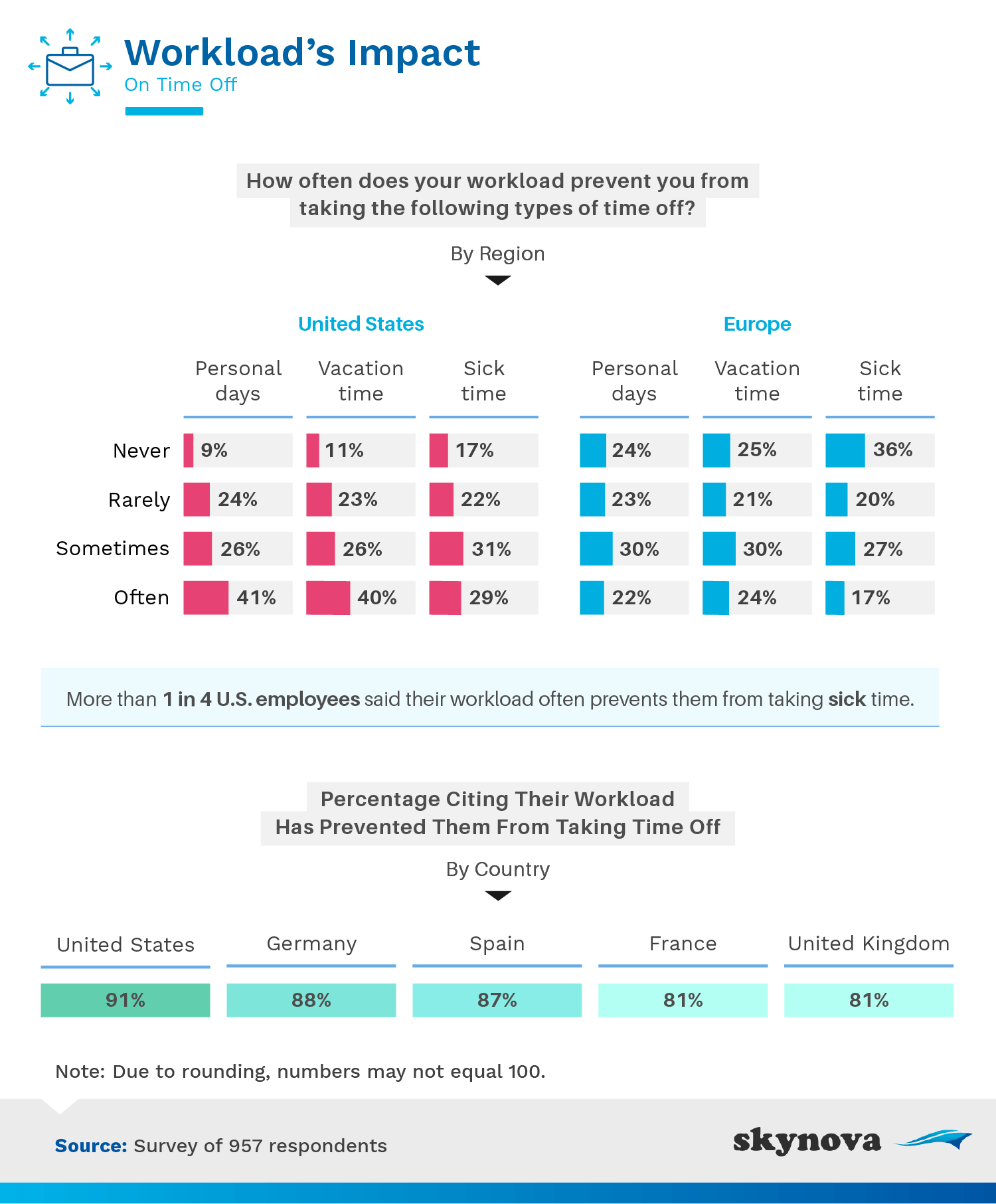
In contrast, a quarter of Europeans surveyed said they never feel pressured by their workloads into not taking personal days (24%) or vacation time (25%), and more than a third said their calendars and inboxes never prohibited them from calling in sick (36%).
In terms of the number of days they get to take off when sick, Americans surveyed fell behind the curve of European employees, but Americans also reported having more flexible sick time and more paid time off during the COVID-19 pandemic.
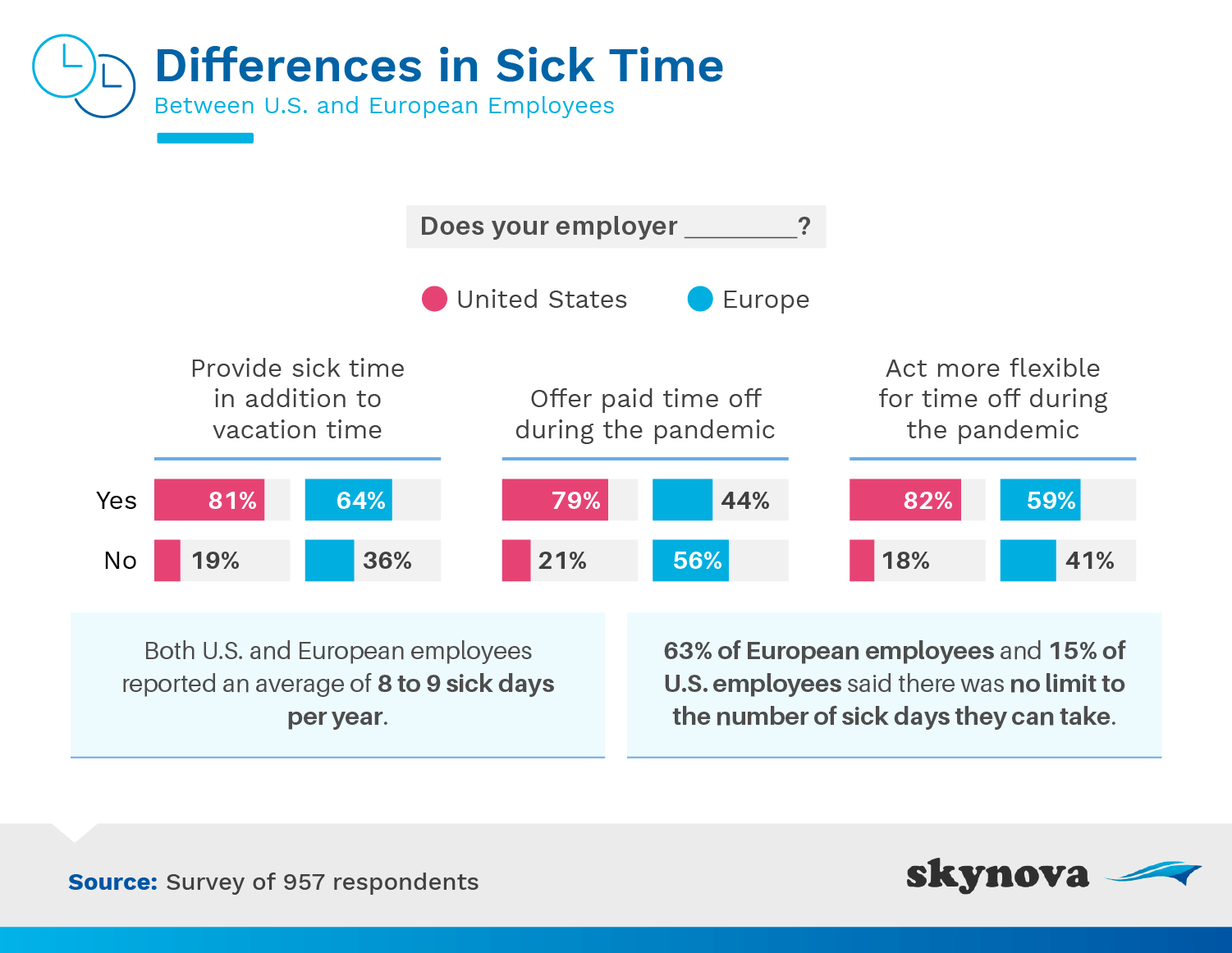
Europeans and Americans both indicated having between eight and nine sick days off per year, though Americans (81%) were more likely than Europeans (64%) to report being given sick days in addition to their vacation time. However, just 15% of Americans said there was no limit to the number of sick days they were allowed to take compared to 63% of European employees.
During the COVID-19 pandemic, flexible work schedules and personal time were more important than ever, and Americans were more likely to acknowledge that their employees had been more accommodating in terms of taking time off. Compared to just 44% of Europeans, 79% of Americans said their employers offered paid time off during the pandemic, and another 82% said their jobs were more relaxed about time off during COVID-19.
Paid time off after having a baby isn't just a subject for women. Studies show men and non-childbearing partners also need time off after a baby is introduced into a household – both for bonding and to balance the duties associated with newborn parenting. However, respondents said their jobs were not always supported:
Among Europeans surveyed, 63% said that their employer offers both paid paternity and maternity leave. In America, working parents are less fortunate. Just 45% of Americans surveyed said their companies offered paid maternity leave, while only 22% said they had access to paid paternity leave. One in 10 Americans said they had no access to either paid maternity or paternity leave.
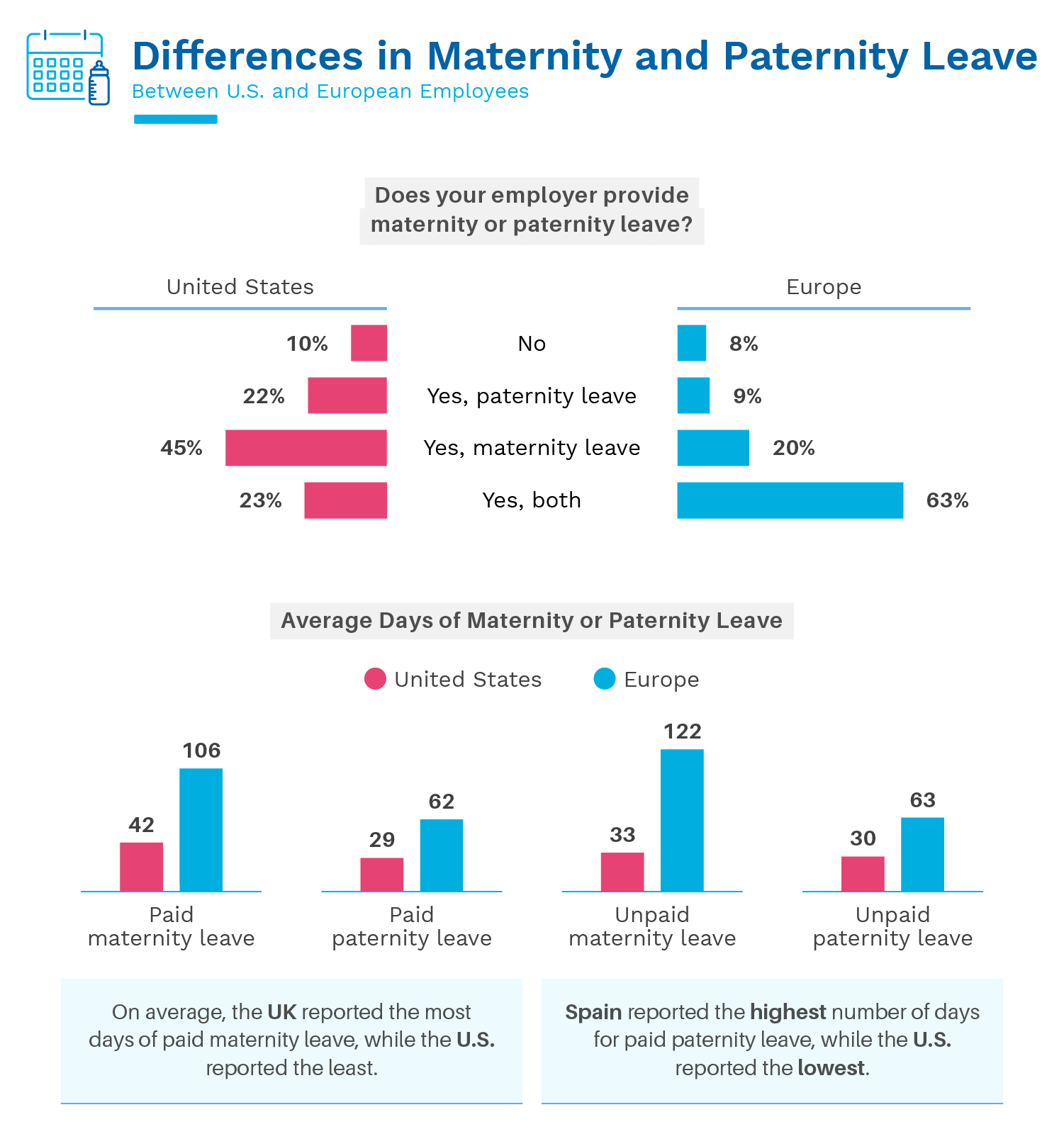
Among those Americans lucky enough to have access to paid time off, the number of days off (either paid or unpaid) was significantly lower compared to European workers. While Europeans reported having an average of 106 paid days off for maternity leave, Americans reported having just 42 days. For those with unpaid leave, Europeans averaged 122 days off, while Americans averaged 33. Europeans with access to paid paternity leave had more than twice as many days off (62) as Americans with paid paternity leave (29).
The end result of firms offering more flexible and generous time-off policies – and creating a culture where employees feel empowered to take that time off – is increased workplace satisfaction, productivity, and job happiness. We asked respondents if their jobs supported them taking time off and analyzed that level of support with their job satisfaction. The findings show that support for time off can directly affect employee satisfaction.
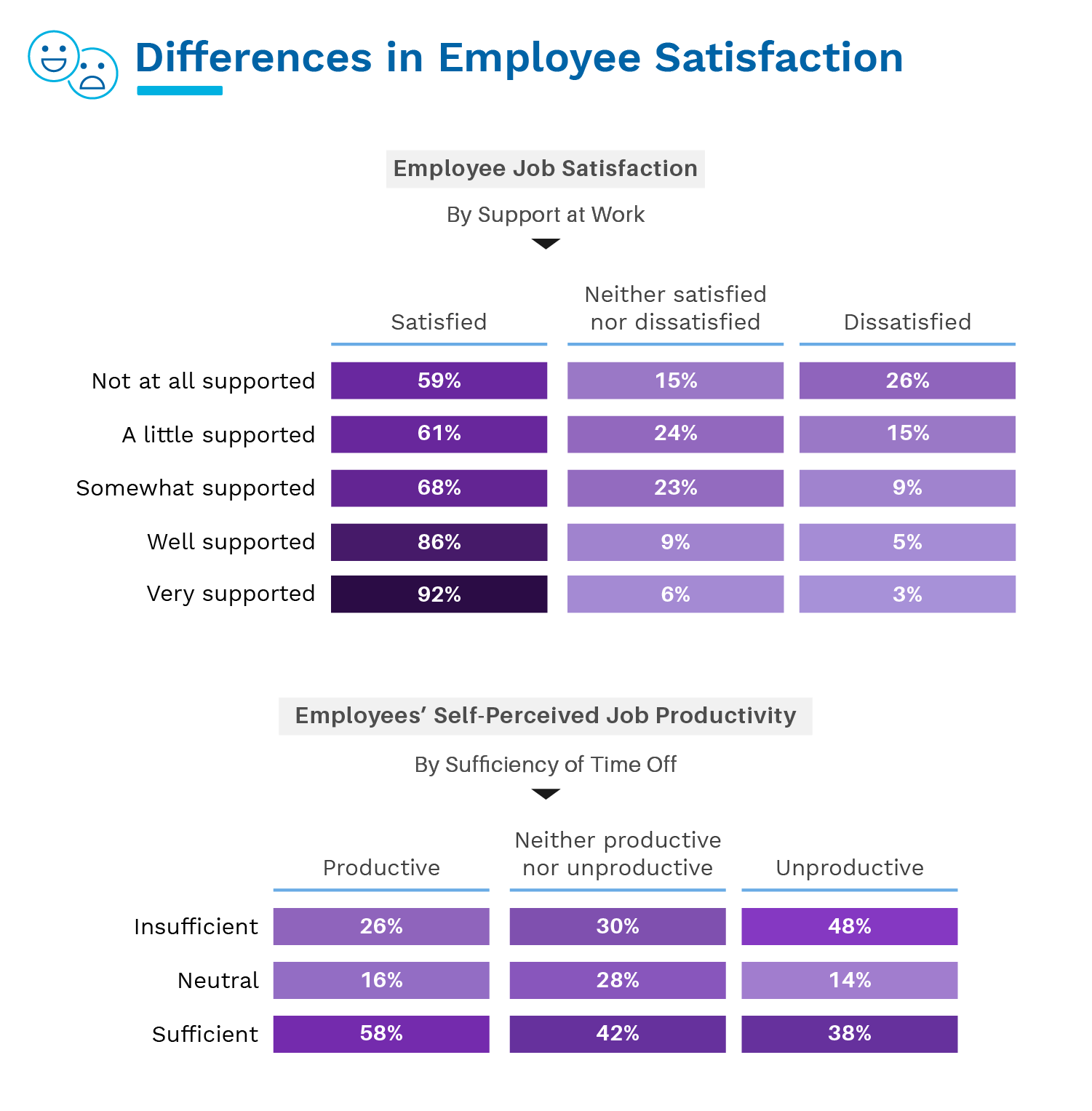
Among employees who said they didn't feel at all supported in taking time off, we found that just 59% were satisfied with their job. This is compared to a 92% satisfaction rating among those who said their jobs very much supported them taking time away. Additionally, 58% of employees who said they had sufficient time off also said they were productive, versus 48% of those who said they had insufficient time off and reported being unproductive.
Effective PTO policies aren't just about the number of days off employees are given, it's also about how supported they feel in taking that time off without repercussions. Our European respondents reported having more time off for personal and vacation use and were more likely to have an unlimited number of sick days available each year. Perhaps more importantly, Europeans reported far more generous paid maternity and paternity leave policies.
The one area in which Americans experienced more flexible working environments was in regard to taking time off during COVID-19. For both Americans and Europeans, having healthy time off policies made them happier with their jobs and more productive when they were at work.
For business owners, there are only so many hours in the day. To help you get everything done even when key staff members are on vacation, Skynova provides online invoicing solutions especially for small businesses. With many unique business templates, we make it easy to send invoices, estimates and quotes, request advance payments, submit business proposals, and more. More than just invoices, our 37 different software solutions help small businesses create the perfect solutions for their needs and cover accounting, receipts, packing slips, and much more. Designed to work together, you can pick the exact modules and templates you need and leave the rest. Learn more online at Skynova.com.
We collected 957 responses from employees in North America and Europe using the Amazon Mechanical Turk survey platform as well as Clickworker. For geographic breakdowns we had 200 respondents from the United States, 200 respondents from the United Kingdom, 200 respondents from Spain, 173 respondents from Germany, 98 respondents from France, and 86 from Canada.
51% of our participants identified as men, 48% identified as women, and roughly 1% identified as nonbinary or nonconforming. Participants ranged in age from 18 to 70. Those who reported no current employment or who failed an attention-check question were disqualified.
The data we are presenting rely on self-report. There are many issues with self-reported data. These issues include, but are not limited to, the following: selective memory, telescoping, attribution, and exaggeration.
Are your readers happy with the amount of time off they get? We encourage you to share the results of this study for any noncommercial use with the inclusion of a link back to this page in your report.